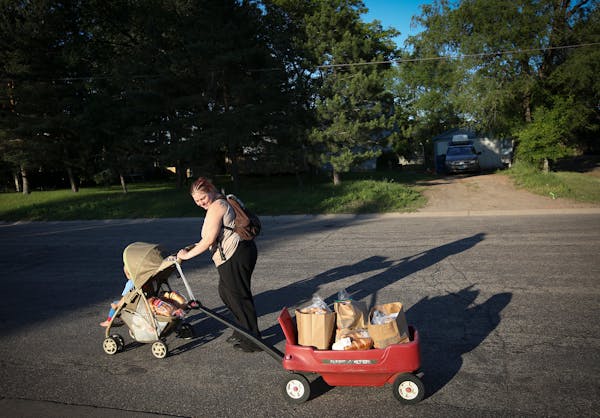Chrisey Yang and her family arrived in Woodbury four years ago, but she doesn't feel part of any huge wave of Hmong suburbanization. And she has but two kids, a steep drop from previous generations.
"These days no one I know is having 10 kids or even six," she said, smiling. "It's expensive! Just child care alone."
The Twin Cities suburbs are more diverse than ever, but the rapid pace of minority growth between 2010 and 2014 has slowed from the previous decade, according to new Census Bureau estimates to be released Thursday. And Yang's observations coincide with what demographers are seeing on their spreadsheets.
"Since 2010 there has been a drop in the birthrate for women of color," said Susan Brower, the state demographer. "It has been a considerable drop-off in a relatively short period of time. We're all kind of watching to see if it's just a pause."
And it mirrors what she's hearing from her colleagues across the nation, Brower added.
The two urban counties, Hennepin and Ramsey, are not seeing the same slowdown. In those counties, Brower suspects, robust population growth is overriding the effects of softening birthrates that are being experienced everywhere.
Minority growth these days even in the suburbs is steady, said Craig Helmstetter, senior research manager at Wilder Research, but it's far from the "staggering" rate it reached not long ago — from 11 percent annually in the 1990s to 3 percent yearly from 2010 to 2013. Anoka County dropped from 13 percent a year in the years 2000 to 2010, to 4 percent in this decade, he noted.
The numbers count because the nation depends more and more on minorities for growth. More whites are dying than being born, census analysts say — about 62,000 more between 2013 and 2014.
And for the first time ever, in 2014, an entire national age group — preschoolers, birth to age 4 — consists of more persons of color (50.2 percent) than whites. That trend is expected to slide up the age spectrum until non-Hispanic whites lose majority status later in this century.
Meanwhile, suburban and exurban counties are the vanguard when it comes to aging, the latest estimates show. Washington, Carver and Sherburne counties are tied in recording the fastest jumps in the state (34 percent) in the 65-to-69 age bracket, as baby boomers turn gray.
More diverse
After the 2010 census documented doublings and triplings of minority numbers in some suburban counties for the decade beginning in 2000, even third- and fourth-ring suburbs such as Shakopee were labeled as "diverse," with 20 percent or more of their population being made up of minorities.
So far this decade, though, average annual growth in people of color in the five purely suburban counties has fallen from about 10,000 last decade to about 7,000 since then.
Most metro counties since 2010 have seen bumps of 1 or 2 percentage points in their minority share: Scott and Anoka for instance, from 15 to 17 percent, Carver from 9 to 10 percent.
In the two urban counties, average annual minority growth has risen from 13,000 to nearly 15,000, shared between Minneapolis, St. Paul and those counties' suburbs. Total annual growth for the two has been about 21,000. The latest census estimates are strictly at the county level.
With younger people the likeliest to move, potential explanations for the urban-suburban differences could include affordability of housing or the rising attractions of urban living for millennials.
But demographer Brower suspects that the main explanation is the drop in minority birthrates. "When you look at growth numbers at the county level," she said, "births are driving that rather than migration."
Whites are not seeing the same drop in births, with differing levels of affluence after the recession, and differing hopes for future stability, being possible reasons.
Learning Swahili
The local library scene illustrates the demographic trends in both minority growth and aging populations.
At Dakota County's Lakeville branch on Wednesday, kids in an African-themed program were learning to count in Swahili, making African masks and listening to the story of "Greedy Zebra" by Mwenye Hadithi.
Tensions between generations, meanwhile, bubbled up recently in Washington County, where older people have dominated public forums on the future of the library system, complaining of confusing online options and a sad loss of human contact as checkouts turn automated.
"We highly value your input," consultant Stu Wilson told a group of aging white library users, gently pointing out that they don't represent the majority of library clients.
Wilson also stressed the importance of libraries as common gathering places for an increasingly diverse society. Indeed, Chrisey Yang said that when she visits, she senses just how diverse Woodbury has become — 22 percent of its 66,000 residents are minorities, in the latest American Community Survey.
"I was in one session [at the childhood center] where half the class was from India," she said — mostly, it seemed, with links to 3M.
David Peterson • 651-925-5039

Minneapolis reaches $150k settlement with eyewitness of George Floyd's murder

Israel-Hamas war creates 'really fraught times' at Minn. colleges

Rare and fatal brain disease in two deer hunters heightens concerns about CWD

